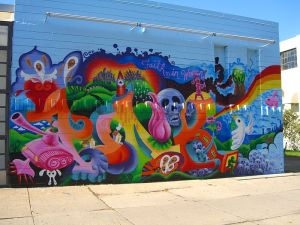“The more they told me: you’re a girl, you can’t paint graffiti, you can’t go to subways, because you’re a girl, you’re a mere female; I had to stand up and just shut them up.” Lady Pink, graffiti and fine artist
Pass through any city and you see it.
Swirls of color, stylized initials, fantastic creatures, and incomprehensible scrawls. Eyesore and art work in one.
In passing under the viaducts of my city’s highways, I always cast an eye toward the graffiti, tags, and other urban art that costs millions to remove and most likely as many man-hours to put in locations that no sane person would ever try to access, can of spray paint in hand. I shake my head recalling an alderman’s efforts to card for spray paint the way you card for cold medicine and cigarettes.
And, my thoughts stray to Lady Pink – also known as Sandra Fabara – the artist widely called “The First Lady of Graffiti.”
Sandra Fabara, born in Ecuador, and raised in Queens, started tagging in 1979 to banish the grief of a break-up. Tagging a boyfriend’s name quickly morphed into murals and the 1980 show “GAS: Graffiti Art Success” at New York’s Fashion Moda and The New Museum of Contemporary Art, led to her rise as a graffiti-world celebrity. At a time when the majority of graffiti artists were men, she blazed a trail in paint on subway cars, walls, and New York’s urban landscape.
From there, it’s been on to roles in film and shows at the Whitney Museum and other prestigious halls of the art world.
Today, she lectures, works on murals, and continues making the art that inspired her as a teenager over 30 years ago.
Visit her Web site. The talent can’t be denied.
What strikes me most, however, is her complete commitment to her purpose, her certainty that this is her medium and no one can tell her where to tag, mural, and paint. She is subversive and stunning, not only through her art but also in her world vision.
In an interview with Jennifer Kreizman, for NEA Arts Magazine, Lady Pink lays that vision on the line:
“We need rebellion in our society. We need someone to question the status quo. Otherwise, our society will be stagnant. Our country is based on rebellion. If not, we’d still be speaking in a nice British accent. The free thinkers, our forefathers, were the ones that set us free, and we still need it in our society.”
While the quote directly relates to a question about graffiti as folk art, one could easily imagine Thomas Jefferson’s similar dogma regarding the refreshment of democracy with a little rebellious activity every now and again.
In the Kreizman interview, the transformative role of graffiti in Lady Pink’s life – and the live of other street artists – is clear when she states, “Doing graffiti taught us a lot of things like college would teach a lot of young people. That was our beginnings. We learned a lot. It gave us backbone. It gave us courage. It gave us confidence. It gave us all these gifts that you get to learn in college; we also picked [them] up. It builds character so that you can stand up for yourself in broad daylight and stand by your work no matter what the criticism. That takes a different kind of courage . . .It’s a huge responsibility to be part of such legitimate and awesome museums like [the Met and Whitney and the Brooklyn Museum]. But I’ve been training all my life for this, beginning since the age of 16. Even at the New Museum, in PS1 at 17, in solo shows at the age of 21. This is my career. This is what I do. I take it very seriously.”
The girl they said was “a mere female,” is one hell of a heroine.
When I see the next shark head or painted overpass, I’ll have to salute it in honor of Lady Pink.
It’s definitely, “Tag, she’s it!”
Images and Other Sources: United Federation of Teachers, “Noteworthy Graduates – Lady Pink, graffiti & fine artist” Dec. 19, 2013, New York Teacher Issue; “Faith in Women” Mural, 2005, Wikimedia Commons image, photo by Jason Taellious.


